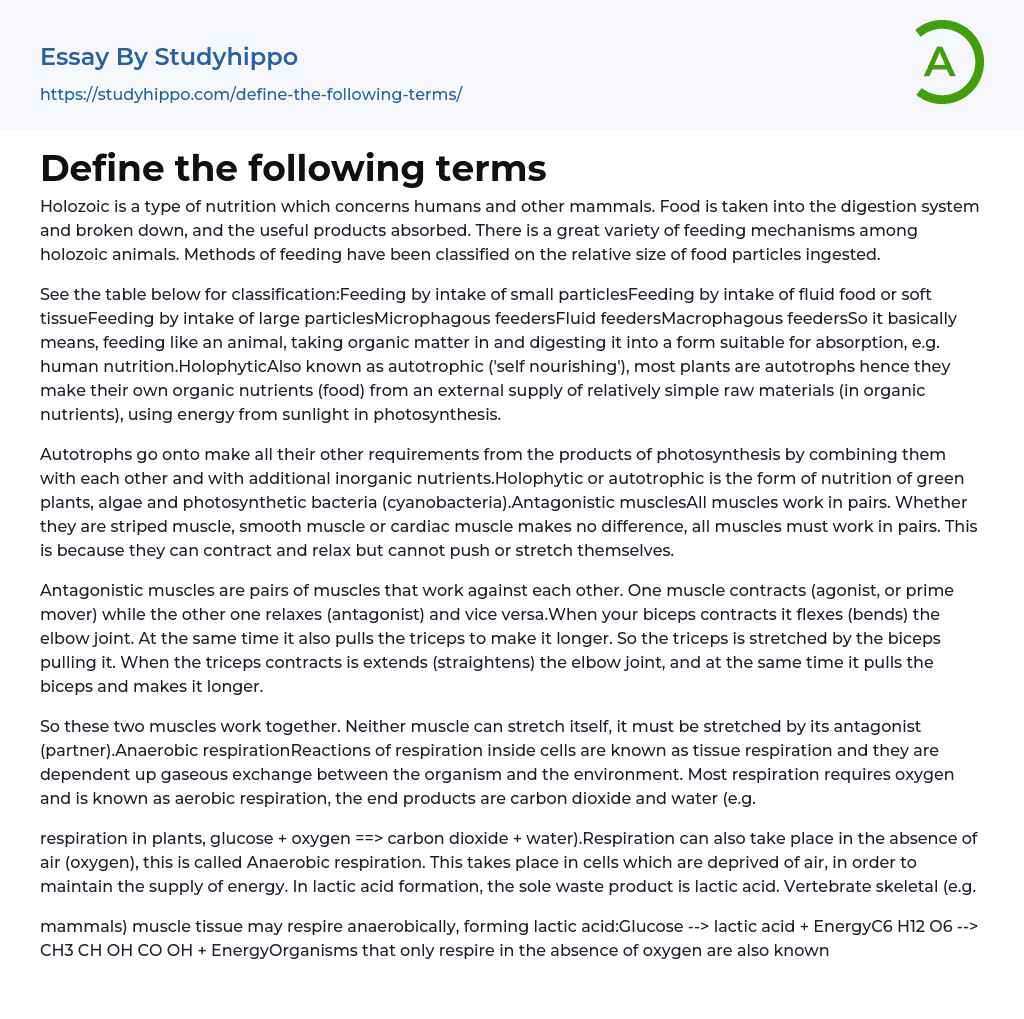
Holozoic nutrition pertains to humans and other mammals, wherein food is ingested into the digestive system and subsequently broken down, with the beneficial elements being assimilated. There are numerous feeding approaches utilized by holozoic creatures, with classification based on the size of the consumed food particles.
The table below provides a classification for feeding based on the intake of small particles, fluid food or soft tissue, and large particles. This means consuming organic matter and digesting it into a form appropriate for absorption, similar to animal feeding, such as human nutrition. Holophytic, also referred to as autotrophic or 'self-nourishing,' is a type of nutrition found mainly in plants. Autotrophs create their organic nutrients or food from relatively simple raw materials inorganic nutrients obtained from an external supply, utilizing energy from sunlight through photosynthesis.
Autotrophs rely on photosy
...nthesis to produce their necessary nutrients, which they combine with inorganic nutrients. Green plants, algae, and cyanobacteria use holophytic or autotrophic nutrition. In the case of all types of muscles - striped, smooth, or cardiac - they function in pairs. Although these muscles can decrease or expand, they are unable to push or lengthen independently.
Antagonistic muscles are muscle pairs that work in opposite directions. One muscle, called the prime mover or agonist, contracts while its paired muscle, known as the antagonist, relaxes. This process is reciprocal. For example, when the biceps contract, the elbow joint flexes (bends) and simultaneously lengthens the triceps as they are pulled by the biceps. Conversely, when the triceps contract, the elbow joint extends (straightens), while simultaneously pulling on and lengthening the biceps.
When stretching, two muscles cooperate, with one receiving assistance from its antagonist. Tissue
respiration involves exchanging gases through cellular reactions with the environment. Oxygen is necessary for aerobic respiration, which generates water and carbon dioxide. Anaerobic respiration also occurs.
The process of respiration involves the metabolic combination of glucose and oxygen by both plants and cells, resulting in the creation of carbon dioxide and water. When oxygen is not available, anaerobic respiration takes place which produces lactic acid as its sole waste product. This type of respiration primarily occurs in the skeletal muscle of vertebrates.
Mammalian muscle tissue has the ability to undergo anaerobic respiration, resulting in the production of lactic acid: Glucose --> lactic acid + Energy or C6 H12 O6 --> CH3 CH OH CO OH + Energy. Obligate anaerobes are organisms that can only respire in the absence of oxygen. Natural selection is a process where organisms better adapted to their environment and possessing competitive advantages survive and reproduce, while less adapted organisms fail to reproduce or die. Stabilizing, directional, and disruptive selection are different types of natural selection which bring about adaptation and evolution within populations in nature through uneven rates of reproduction, ultimately altering gene frequencies.
Natural selection is responsible for the adaptation of animals and plants to their environment. Less efficient ones have a lower probability of passing on their genes through reproduction. During the Industrial Revolution, air pollution, such as sulphur dioxide, blanketed industrial areas. As a result, lichens and mosses died off from surfaces like tree trunks and brickwork, leaving behind blackened regions known as industrial melanism.
Industrial melanism is a phenomenon where the proportion of darkened forms of moth increases in habitats due to their better camouflage, leading to an increase in
the frequency of their genes being passed forward to the next generation. This period saw a rise in the amount of dark variety species of moth. To learn more about cellular respiration breaking down energy, click
here.
Osmosis refers to the diffusion of water molecules across a selectively permeable membrane in living organisms. Water moves from an area of higher concentration to lower concentration or from a hypotonic solution to a hypertonic solution. It can also move from a hyperosmotic solution to a hypo-osmotic solution or from an area of high water potential to lower water potential. The diagram below shows a model of osmosis.
Active transport is another type of molecule transportation where molecules move from lower to higher concentration using protein carrier molecules known as Biological pumps.
Active transport is necessary to move ions against their concentration gradient, and this process always requires energy. For instance, a plant’s Mg2+ ion concentration may be greater than that of the surrounding soil, and the plant acquires Mg2+ ions via active transport through its root hair cell membranes. Only specific protein carriers can facilitate the entry of Mg2+ ions into the plant.
Active ion uptake can also be referred to as a type of active transport.
- Microbiology essays
- Bacteria essays
- Cell essays
- Enzyme essays
- Photosynthesis essays
- Plant essays
- Natural Selection essays
- Protein essays
- Viruses essays
- Cell Membrane essays
- Human essays
- Stem Cell essays
- Breeding essays
- Biotechnology essays
- Cystic Fibrosis essays
- Tree essays
- Seed essays
- Coronavirus essays
- Zika Virus essays
- Accounting essays
- Marketing essays
- Automation essays
- Business Cycle essays
- Business Model essays
- Business Operations essays
- Business Software essays
- Corporate Social Responsibility essays
- Infrastructure essays
- Logistics essays
- Manufacturing essays
- Multinational Corporation essays
- Richard Branson essays
- Small Business essays
- Cooperative essays
- Family Business essays
- Human Resource Management essays
- Sales essays
- Market essays
- Online Shopping essays
- Selling essays
- Strategy essays
- Management essays
- Franchising essays
- Quality Assurance essays
- Business Intelligence essays
- Corporation essays
- Stock essays
- Shopping Mall essays
- Harvard Business School essays
- Harvard university essays



